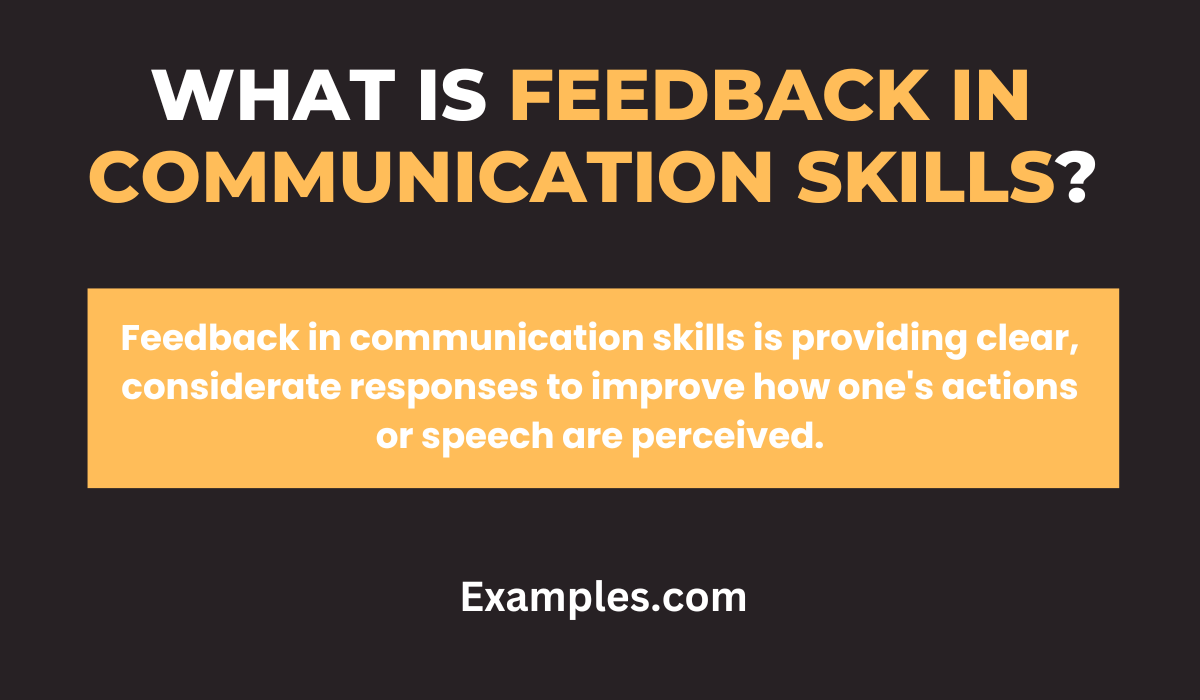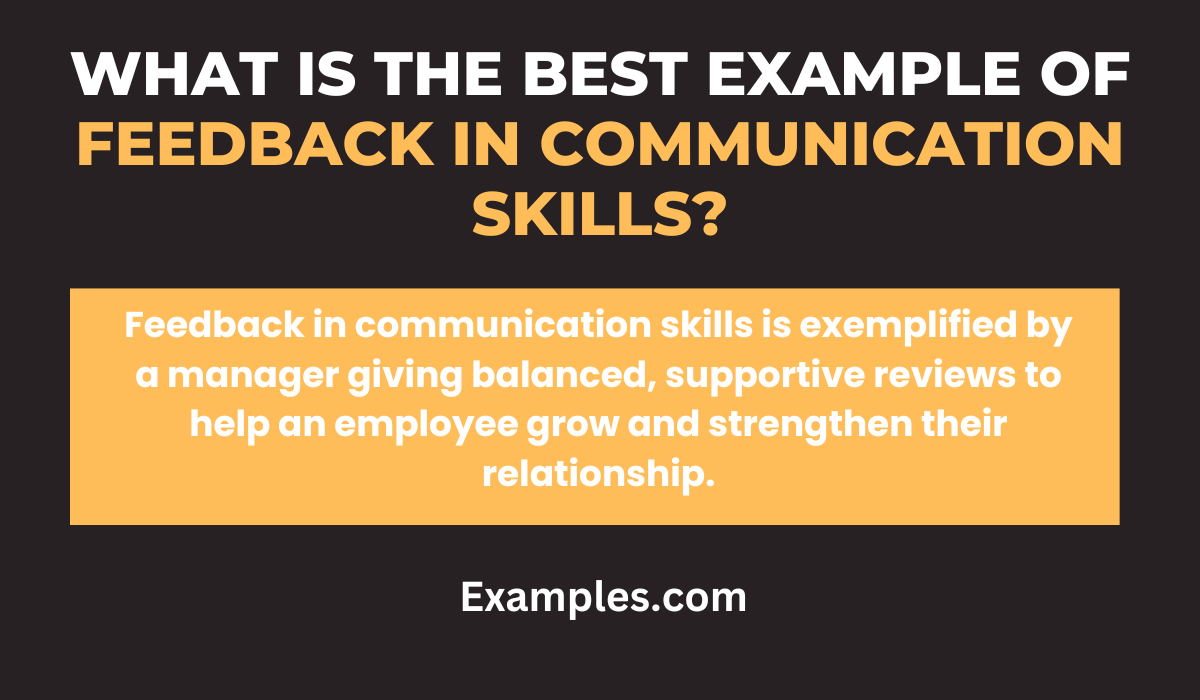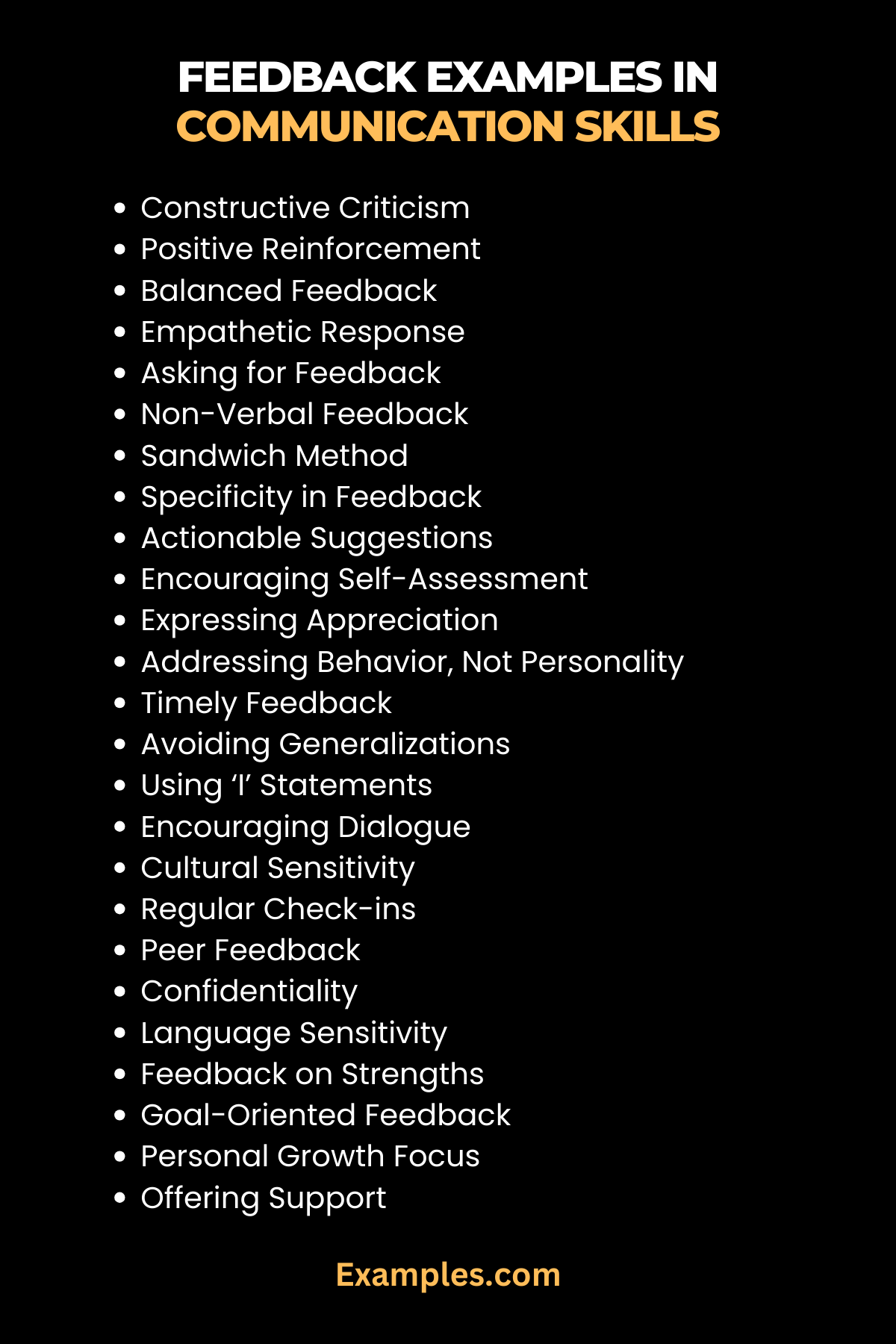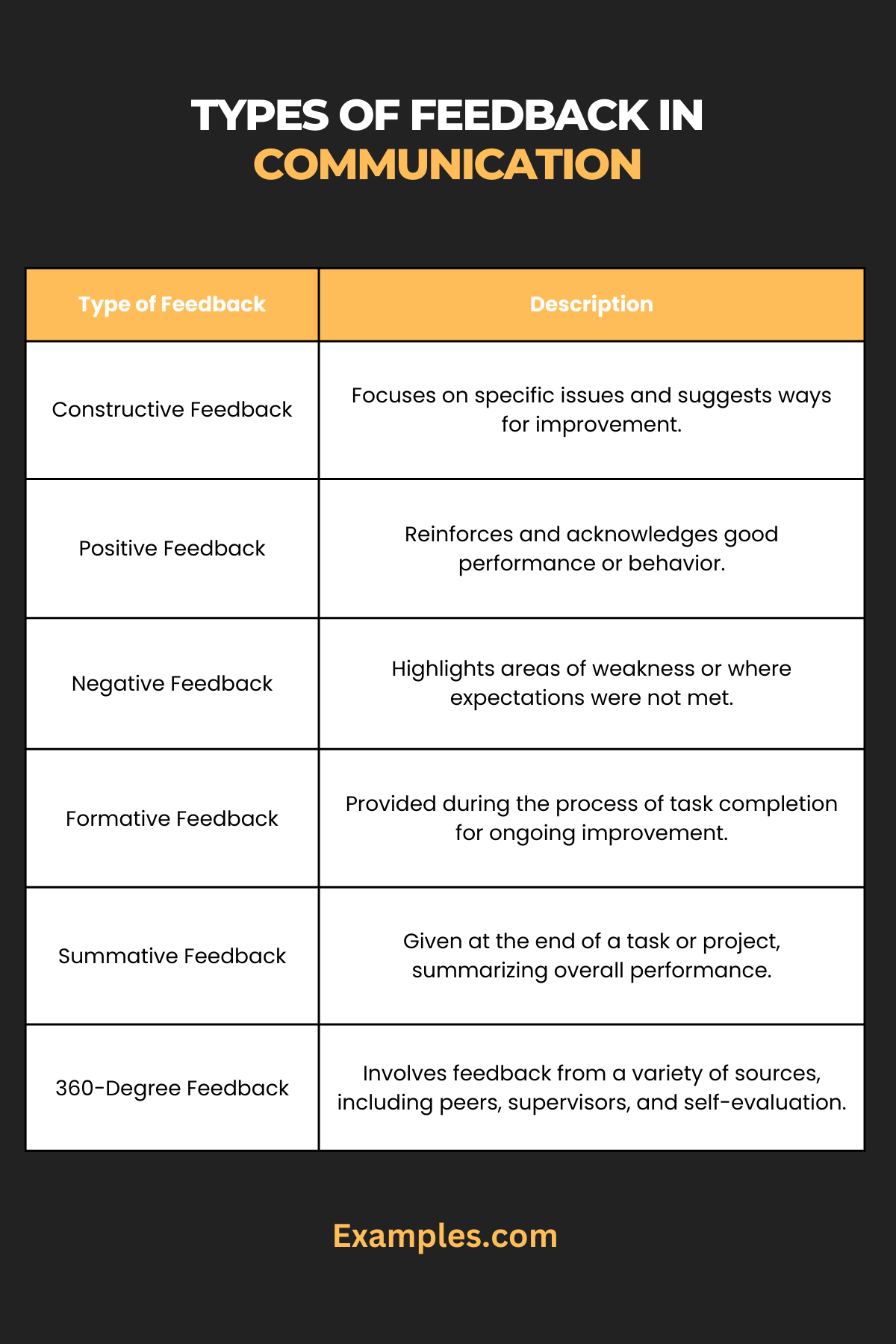Feedback in Communication Skills
Feedback is a vital component of effective communication, serving as a bridge between understanding and improvement. This guide explores the nuances of Feedback in Communication Skills, integrating various Communication Examples to illustrate its impact. From offering constructive criticism to receiving feedback gracefully, this guide covers essential strategies to enhance your communication skills. Whether in the workplace, in education, or personal relationships, these insights will empower you to engage in feedback processes more effectively, fostering growth and understanding.
What is Feedback in Communication Skills?
Feedback in Communication Skills refers to the process of providing constructive criticism, reactions, or responses to someone’s actions or speech. It plays a crucial role in communication by helping individuals understand how their message is perceived and how it can be improved. Effective feedback is clear, specific, and delivered in a way that is considerate of the recipient’s feelings and perspective.

What is the Best Example of Feedback in Communication Skills?
A prime example of Feedback in Communication Skills is a manager reviewing an employee’s work performance. The manager provides specific, balanced feedback that highlights areas of strength and areas for improvement. This feedback is delivered in a supportive manner, encouraging the employee to develop skills while acknowledging their achievements. Such an approach not only helps the employee grow but also strengthens their relationship with the manager.

30 Feedback Examples in Communication Skills
Feedback in Communication Skills is an essential aspect of effective interaction, pivotal for personal and professional growth. This guide offers 30 distinct examples, each demonstrating how to give and receive feedback constructively. These examples, enriched with practical communication strategies, provide insights into crafting feedback that is both informative and empathetic. Whether in a leadership role, among peers, or in personal relationships, mastering feedback skills is key to fostering understanding, improvement, and positive change.

- Constructive Criticism: Offer feedback that is specific and focuses on improvement.
Example: “Your report was very thorough, but adding more data analysis could enhance its impact.” - Positive Reinforcement: Acknowledge what has been done well to motivate further.
Example: “Your presentation was very engaging; your enthusiasm really came through.” - Balanced Feedback: Combine positive comments with areas for growth.
Example: “You’ve made great progress on this project. Let’s work on meeting the deadlines more consistently.” - Empathetic Response: Show understanding and empathy when giving feedback.
Example: “I understand the challenges you faced, and I appreciate your effort in this situation.” - Asking for Feedback: Encourage a culture of open communication by requesting feedback.
Example: “I’d love to hear your thoughts on how I can improve this project.”

- Non-Verbal Feedback: Use body language to convey agreement or concern.
Example: Nodding in agreement while saying, “I see your point, and it’s a valid one.” - Sandwich Method: Encase constructive criticism between positive comments.
Example: “Your creativity is impressive. Focusing on timeliness could enhance your project’s effectiveness. Keep up the good work!
- Specificity in Feedback: Be clear and specific in your comments.
Example: “The data you provided was accurate, but presenting it in a more organized way will increase its clarity.” - Actionable Suggestions: Provide clear suggestions for improvement.
Example: “To improve your report, I suggest adding more real-life examples.” - Encouraging Self-Assessment: Prompt others to evaluate their own work.
Example: “How do you feel about your project’s progress and what areas do you think you could improve?” - Expressing Appreciation: Recognize and appreciate the effort.
Example: “Thank you for your hard work on this, it really shows in the results.” - Addressing Behavior, Not Personality: Focus on actions and behaviors rather than personal traits.
Example: “In meetings, I’ve noticed you interrupt others often. Let’s work on improving this aspect.” - Timely Feedback: Offer feedback soon after the relevant event or action.
Example: “Regarding today’s meeting, I think addressing the points more concisely would be more effective.” - Avoiding Generalizations: Steer clear of vague comments.
Example: “In your presentation, the statistics in the second slide need more clarity.” - Using ‘I’ Statements: Communicate your perspective without assigning blame.
Example: “I felt a bit confused by the conclusions in your report.” - Encouraging Dialogue: Foster a two-way communication while giving feedback.
Example: “I have some thoughts on your project, but I’d like to hear your perspective as well.” - Cultural Sensitivity: Be aware of cultural differences in giving and receiving feedback.
Example: “I understand that our cultural backgrounds may influence how we view this, so I’m open to hearing your approach.” - Regular Check-ins: Provide consistent feedback to facilitate ongoing development.
Example: “Let’s schedule regular check-ins to discuss your progress and areas for improvement.” - Peer Feedback: Encourage peer-to-peer feedback for diverse perspectives.
Example: “I’d like you to partner with a colleague for mutual feedback on this project.” - Confidentiality: Respect privacy when giving sensitive feedback.
Example: “Let’s talk privately about the areas in your performance that need attention.” - Language Sensitivity: Use language that is clear but not harsh.
Example: “I believe you could enhance the impact of your writing by being more concise.” - Feedback on Strengths: Highlight strengths to build confidence.
Example: “Your ability to quickly understand complex concepts is a great asset.” - Goal-Oriented Feedback: Align feedback with goals and objectives.
Example: “To align with our team’s goals, let’s focus on enhancing your project management skills.” - Personal Growth Focus: Frame feedback in a way that emphasizes personal development.
Example: “This challenge is a great opportunity for you to demonstrate your leadership skills.”

- Offering Support: Show willingness to help in the improvement process.
Example: “I noticed you’re struggling with this task. How can I assist you?” - Receiving Feedback Graciously: Demonstrate openness when receiving feedback.
Example: “Thank you for your feedback; I’ll reflect on these points and work on them.” - Constructive Group Feedback: In group settings, give feedback that benefits the collective.
Example: “As a team, we should focus on improving our collaborative processes.” - Avoiding Overload: Don’t overwhelm with too much feedback at once.
Example: “Let’s start by focusing on improving this key area first.” - Continuous Improvement Encouragement: Motivate continuous learning and improvement.
Example: “Keep seeking ways to enhance your skills; you’re on the right track.” - Feedback Follow-Up: Check back on progress after giving feedback.
Example: “Since our last discussion, how do you feel about your improvements in project management?”
Types of Feedback in Communication
In the realm of Emotional Intelligence in Communication, understanding different types of feedback is crucial. Feedback in communication can take various forms, each serving a unique purpose and function. This section provides an overview of the different types of feedback, presented in a table format for clarity. Recognizing and utilizing these types effectively can significantly enhance the quality of both personal and professional interactions.

| Type of Feedback | Description | Use in Communication |
|---|---|---|
| Constructive Feedback | Focuses on specific issues and suggests ways for improvement. | Used to encourage growth and improvement in a supportive manner. |
| Positive Feedback | Reinforces and acknowledges good performance or behavior. | Used to motivate and encourage continued good practice. |
| Negative Feedback | Highlights areas of weakness or where expectations were not met. | Used cautiously to address problems while maintaining motivation. |
| Formative Feedback | Provided during the process of task completion for ongoing improvement. | Used to guide and shape the behavior as it happens. |
| Summative Feedback | Given at the end of a task or project, summarizing overall performance. | Used to provide a comprehensive overview of performance. |
| 360-Degree Feedback | Involves feedback from a variety of sources, including peers, supervisors, and self-evaluation. | Used for a well-rounded view of performance and behaviors. |
| Peer Feedback | Feedback given by colleagues or equals in the workplace. | Used to share perspectives among peers for mutual development. |
| Self-Feedback | Self-assessment of one’s own performance and behavior. | Used for personal reflection and self-improvement. |
| Informal Feedback | Casual, unscheduled feedback in everyday interactions. | Used for spontaneous, real-time observations and comments. |
| Formal Feedback | Structured and planned, often documented feedback. | Used in official evaluations and performance reviews. |
Why is Feedback Important to the Communication Process in the Workplace?
Feedback is a cornerstone of effective workplace communication, fostering a culture of continuous improvement and mutual respect.
- Enhances Performance: Regular feedback helps employees understand how well they are doing and where they can improve.
- Promotes Learning and Development: Feedback is an essential tool for professional growth and skill development.
- Boosts Employee Engagement: Receiving feedback makes employees feel valued and part of the team.
- Facilitates Open Communication: Feedback encourages a two-way communication channel between employees and management.
- Improves Relationships: Constructive feedback can strengthen relationships by building trust and understanding.
- Encourages a Positive Workplace Culture: A culture that values feedback is often more collaborative and innovative.
- Helps in Conflict Resolution: Feedback can help address issues before they escalate into conflicts.
- Guides Career Development: Feedback provides insights that can guide an employee’s career path.
- Increases Job Satisfaction: Employees who receive regular, constructive feedback often feel more satisfied with their jobs.
- Drives Organizational Success: Effective feedback can lead to better performance and, in turn, contribute to organizational success.
How to Write Feedback in Communication?
Feedback in Communication is a skill that requires thoughtfulness, clarity, and a constructive approach. Writing feedback effectively can significantly impact the recipient’s understanding and response.
- Be Clear and Specific: Avoid vagueness; be specific about what was done well or needs improvement.
- Focus on the Behavior, Not the Person: Address the action or behavior rather than personal attributes.
- Use ‘I’ Statements: Frame your feedback from your perspective to avoid sounding accusatory.
- Provide Examples: Reference specific instances to illustrate your points.
- Offer Solutions or Suggestions: Don’t just point out problems; provide recommendations for improvement.
- Balance Positive and Negative Comments: Try to include positive feedback alongside any criticisms.
- Be Honest but Diplomatic: Convey your message honestly but considerately.
- Encourage Dialogue: Invite the recipient to discuss the feedback for clarity and understanding.
- Check for Tone: Ensure your written feedback is respectful and empathetic.
- Follow-Up: Offer to discuss the feedback in person and provide further support if needed.
Emotional Intelligence in Communication plays a transformative role in how we interact, understand, and influence others. This guide has provided a comprehensive insight into the nuances of emotional intelligence in communication, focusing on the types and significance of feedback. By integrating these concepts, one can effectively navigate complex interpersonal dynamics, foster constructive relationships, and achieve personal and professional growth.



